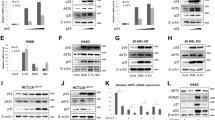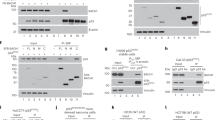Abstract
p53 exerts its tumor suppressor effects by activating genes involved in cell growth arrest and programmed cell death. The p53 target genes inducing growth arrest are well defined whereas those inducing apoptosis are not fully characterized. Proapoptotic activity of p53 was shown to involve several genes like Bax, Noxa and Puma, which may function in the release of cytochrome c from the mitochondria. Cytochrome c associates with Apaf-1 and caspase 9 to form the apoptosome. Genetic and cellular data indicate that Apaf-1 deficiency abrogates the apoptotic effect of p53 and substitutes for p53 loss in promoting tumor formation. Here we show that Apaf-1, the mammalian homologue of C. elegans CED4, is a direct target of p53 as demonstrated by gel shift analysis of the target site sequence in the presence of p53 and by Apaf-1 promoter-luciferase assays. We also show that the p53 activation of the Apaf-1 luciferase construct can be enhanced by the putative tumor suppressor gene product, Zac-1, a transcription factor that has previously been shown to inhibit cell proliferation. Furthermore, we demonstrate that Zac-1 is a possible direct target of p53 since the sequence upstream to the first coding exon of Zac-1 contains a p53 recognition site and the luciferase construct containing this region is activated by p53. These results suggests the existence of a tightly controlled self amplifying mechanism of transcriptional activation leading to apoptosis by p53.
This is a preview of subscription content, access via your institution
Access options
Subscribe to this journal
Receive 50 print issues and online access
$259.00 per year
only $5.18 per issue
Buy this article
- Purchase on Springer Link
- Instant access to full article PDF
Prices may be subject to local taxes which are calculated during checkout







Similar content being viewed by others
References
Aravind L, Dixit VM, Konnin EV . 2001 Science 291: 1279–1284
Arima T, Drewell RA, Oshimura M, Wake N, Surani MA . 2000 Genomics 67: 248–255
Bates S, Vousden KH . 1999 Cell. Mol. Life Sci. 55: 28–37
Bilanges B, Varrault A, Basyuk E, Rodriguez C, Mazumdar A, Pantaloni C, Bockaert J, Theillet C, Spengler D, Journot L . 1999 Oncogene 18: 3979–3988
Cecconi F, Alvarez-Bolado G, Meyer BI, Roth KA, Gruss P . 1998 Cell 94: 727–737
Deng C, Zhang P, Harper JW, Elledge SJ, Leder P . 1995 Cell 82: 675–684
el-Deiry WS, Kern SE, Pietenpol JA, Kinzler KW, Vogelstein B . 1992 Nat. Genet. 1: 45–49
Gottlieb TM, Oren M . 1998 Semin. Cancer Biol. 8: 359–368
Gross A, McDonnell JM, Korsmeyer SJ . 1999 Genes Dev. 13: 1899–1911
Huang SM, Stallcup MR . 2000 Mol. Cell. Biol. 20: 1855–1867
Huang SM, Schonthal AH, Stallcup MR . 2001 Oncogene 20: 2134–2143
Jia L, Srinivasula SM, Liu FT, Newland AC, Fernandes-Alnemri R, Alnemri ES, Kelsey SM . 2001 Blood 98: 414–421
Jiang X, Wang X . 2000 J. Biol. Chem. 275: 31199–31203
Jimenez GS, Nister M, Stommel JM, Beeche M, Barcarse EA, Zhang X-Q, O'Gorman S, Wahl GM . 2000 Nat. Genet. 26: 37–43
Kannan K, Amariglio N, Rechavi G, Jakob-Hirsch J, Kela I, Kaminski N, Getz G, Domany E, Givol D . 2001a Oncogene 20: 2225–2234
Kannan K, Kaminski N, Rechavi G, Jakob-Hirsch J, Amariglio N, Givol D . 2001b Oncogene 20: 3449–3455
Kelekar A, Thompson CB . 1998 Trends Cell Biol. 8: 324–330
Levine AJ . 1997 Cell 88: 323–331
Miyashita T, Reed JC . 1995 Cell 80: 293–299
Moroni MC, Hickman ES, Denchi EL, Caprara G, Colli E, Cecconi F, Muller H, Helin K . 2001 Nat. Cell. Biol. 3: 552–558
Nakano K, Vousden KH . 2001 Mol. Cell 7: 683–694
Oda E, Ohki R, Murasawa H, Nemoto J, Shibue T, Yamashita T, Tokino T, Taniguchi T, Tanaka N . 2000 Science 288: 1053–1058
Reed JC . 1999 J. Clin. Oncol. 17: 2941–2953
Robles AI, Bemmels NA, Foraker AB, Harris CC . 2001 Cancer Res. 61: 6660–6664
Samuels-Lev Y, O'Connor DJ, Bergamaschi D, Trigiante G, Hsieh JK, Zhong S, Campargue I, Naumovski L, Crook T, Lu X . 2001 Mol. Cell. 8: 781–794
Soengas MS, Alarcon RM, Yoshida H, Giaccia AJ, Hakem R, Mak TW, Lowe SW . 1999 Science 284: 156–159
Soengas MS, Capodieci P, Polsky D, Mora J, Esteller M, Opitz-Araya X, McCombie R, Herman JG, Gerald WL, Lazebnik YA, Cordon-Cardo C, Lowe SW . 2001 Nature 409: 207–211
Spengler D, Villalba M, Hoffmann A, Pantaloni C, Houssami S, Bockaert J, Journot L . 1997 EMBO J. 16: 2814–2825
Thornborrow EC, Manfredi JJ . 1999 J. Biol. Chem. 274: 33747–33756
Varrault A, Bilanges B, Mackay DJG, Basyuk E, Ahr B, Fernandez C, Robinson DO, Bockaert J, Journot L . 2001 J. Biol. Chem. 276: 18653–18656
Varrault A, Ciani E, Apiou F, Bilanges B, Hoffmann A, Pantaloni C, Bockaert J, Spengler D, Journot L . 1998 Proc. Natl. Acad. Sci. USA 95: 8835–8840
Yonish-Rouach E, Resnitzky D, Lotem J, Sachs L, Kimchi A, Oren M . 1991 Nature 352: 345–347
Yoshida H, Kong YY, Yoshida R, Elia AJ, Hakem A, Hakem R, Penninger JM, Mak TW . 1998 Cell 94: 739–750
Yu J, Zhang L, Hwang PM, Kinzler KW, Vogelstein B . 2001 Mol. Cell 7: 673–682
Zou H, Li Y, Liu X, Wang X . 1999 J. Biol. Chem. 274: 11549–11556
Acknowledgements
We thank Dr Moshe Oren for the baculovirus recombinant p53, the p53 cDNA constructs and pAb421 and for helpful discussion. We thank Dr M Stallcup for the Zac-1 construct and Dr X Wang for the Apaf-1 construct. This work was supported in part by the Arison Dorsman donation, the Yad Abraham Center for Cancer Diagnosis and Therapy and the Germany Israel Science Foundation (GIF). G Rechavi holds the Gregorio and Dora Shapiro Chair for Hematology Malignancies, Sackler School of Medicine Tel Aviv University. Part of this work was performed in partial fulfilment of the requirement of the Ph. D. degree of Galit Rozenfeld-Granot, Sackler Faculty of Medicine, Tel Aviv University.
Author information
Authors and Affiliations
Corresponding author
Rights and permissions
About this article
Cite this article
Rozenfeld-Granot, G., Krishnamurthy, J., Kannan, K. et al. A positive feedback mechanism in the transcriptional activation of Apaf-1 by p53 and the coactivator Zac-1. Oncogene 21, 1469–1476 (2002). https://doi.org/10.1038/sj.onc.1205218
Received:
Revised:
Accepted:
Published:
Issue Date:
DOI: https://doi.org/10.1038/sj.onc.1205218
Keywords
This article is cited by
-
Exploring the multiple roles of guardian of the genome: P53
Egyptian Journal of Medical Human Genetics (2020)
-
p53 dynamics orchestrates with binding affinity to target genes for cell fate decision
Cell Death & Disease (2017)
-
Census and evaluation of p53 target genes
Oncogene (2017)
-
Apoptosis induced by low-level laser in polymorphonuclear cells of acute joint inflammation: comparative analysis of two energy densities
Lasers in Medical Science (2017)
-
Apoptotic-induced cleavage shifts HuR from being a promoter of survival to an activator of caspase-mediated apoptosis
Cell Death & Differentiation (2013)



